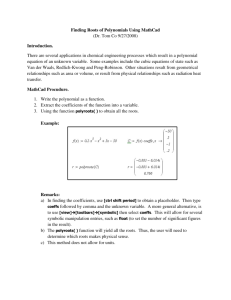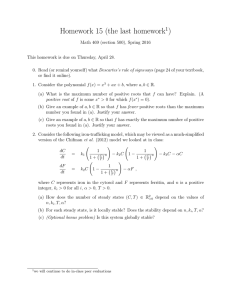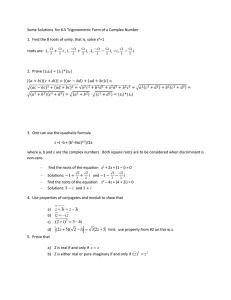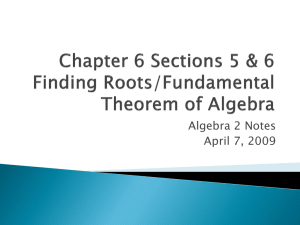Document 10910975
advertisement
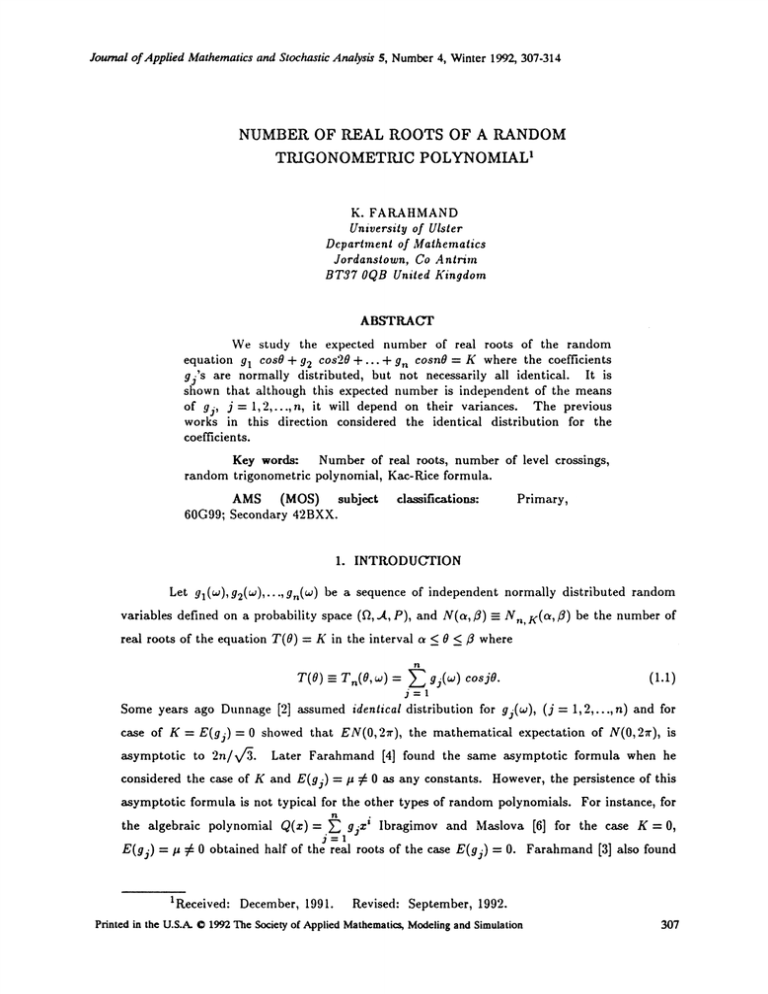
Journal of Applied Mathematics and Stochastic Analysis 5, Number 4, Winter 1992, 307-314
NUMBER OF IAL ROOTS OF A RANDOM
TRIGONOMETR2C POLYNOMIAL
K. FAtLAHMAND
University
of Ulster
Department of Mathematics
Jordanstown, Co A ntrim
BT37 OQB United Kingdom
ABSTRACT
We study the expected number of real roots of the random
equation gl cosO + g2 cos20 +... + gn cosnO = K where the coefficients
gj’s are normally distributed, but not necessarily all identical. It is
shown that although this expected number is independent of the means
of gj, j = 1,2,...,n, it will depend on their variances. The previous
works in this direction considered the identical distribution for the
coefficients.
Key words: Number of real roots, number of level crossings,
random trigonometric polynomial, Kac-Rice formula.
AMS (MOS) subject
60G99; Secondary 42BXX.
classifications:
Primary,
1. INTRODUCTION
Let gl(w),g2(w),...,gn(W) be
a sequence of independent
normally distributed random
(f2,.A, P), and g(a,)_= gn, K(O,l) be the number of
real roots of the equation T(O) = K in the interval a < 0 _< fl where
variables defined on a probability space
T(O) =_ Tn(a, ) =
E gJ(w) cosjO.
(1.1)
2=1
Some years ago Dunnage [2] assumed identical distribution for gj(), (j = 1, 2,. n) and for
case of K = E(gj)- 0 showed that EN(0,27r), the mathematical expectation of N(0,27r), is
asymptotic to 2n/v. Later Farahmand [4] found the same asymptotic formula when he
considered the case of K and E(gj) = p 0 as any constants. However, the persistence of this
asymptotic formula is not typical for the other types of random polynomials. For instance, for
gjz Ibragimov and Maslova [6] for the case K = 0,
0 obtained half of the real roots of the case E(gj) = 0. Farahmand [3] also found
the algebraic polynomial Q(x)=
E(gj) = p
1Received: December,
1991.
Revised: September, 1992.
Printed in the U.S.A. (C) 1992 The Society of Applied Mathematics, Modeling and Simulation
307
K. FARAHMAND
308
a reduction in the
K = 0. Very
number of real roots when he considered the case of K
recent, ly
:# 0
rather than
in two interesting papers involving several new methods, Wilkins
dramatically reduces the error term for the case of K
= 0,
[10, 11]
considerably improving the previous
result.
In this paper, for the random trigonometric polynomial (1.I), we will study the case
when the means and variances of the coefficients gj are not necessarily all equal. It will be
shown that EN(0,2r) will be independent of E(gj) and K, but dependent on the var(gj). For
/1, /2,
"12 and r as any bounded absolute constants, we prove the following theorem:
coefficients gi’ j = 1,2,...,n of T(O) are normally distributed with
means and variances Pl and al >0 for <_ j <_ n and P2 and
> O for n < j <_ n,
respectively, then for any sequence of constants K n = K, such that K2/(naa2 + nr) tends to
Theorem:
If
the
o’
zero as ni tends to infinity, the mathematical epectation
equation T(O) = K satisfies
3
riley
2+(n
3
3
of
2
nl)"2
the number
1
of real
roots
of the
1
Comparing his result, with the algebraic case with non-identically distributed coefficients
sudied in
Tha
[5], shows another ineresfing
difference between these
wo ypes of polynomials.
is, for the algebraic case, he behavior of the number of real roots is dictated by the
means and is independent of variances while, in contrast, for the trigonometric case, this
number depends on he variances and no on he means. In he proof of the theorem, he
2
/2, rl2, r2 are independen of n is no necessary, bu he gain in stating a
marginally more general conclusion subject to a very ungainly hypothesis seems insignificant.
assumption
that./1,
2. PROOF. OF TIlE TtIEOREM
We first look at the polynomial T(O)- K as a non-stationary normal process with 1
and A 2, say, as its mean and variance and A 2 and B 2, say, as the mean and variance of its
derivative, respectively. Then we can use Cromer and Leadbetter’s
[1, page 285] result for the
level crossings of this type of process to get,
EN(a,) =
/(B/A)(1 -C2/A2B2)7(A/A)[2(rl) + r/{2(I)(r)
where
C = COV[{T(O)- K}, T’(0)], rl = (CA- A2A2)/AzX,
1}]d0
(2.1)
Number of Real Roots
A2
of a Randoln Trigonotnetric Polynomial
A2B2_C’ (t) =
3O9
(2r)-7 ep(-y2/2)dy
(t) = q)’(t) = (2’)-Tezp(-
and
Now since (t)- 1/2+(r)-Terf(t/V.) where err(x)=
extension of the Kac-Rice
exp(- tZ)dt from (2.1) we have the
f
[7] formula
EN(c,/3) =
i [(A/rA2)ezP{
4-(V/-/r)A -3 A2A 2 Cl
exp
(B2 2CAiA2 + A2A)/2A2}
A’/2A2)er f( A2A2 CA /V/-AA)IdO
/ l,(O)dO + / 12(O)dO
=
say.
(2.2)
We divide the interval (0,2r) into two groups of subintervals. The first group of subintervals
includes the -neighborhood of 0, and 2r and the second lies outside these e-neighborhoods. As
in [4], we need further modification of Dunnage’s [2] approach which is based on an application
of Jensen’s theorem [9, page 125] or [8, page 332]. By choosing e sufficiently small and
applying this approach we will be able to show that the expected number of real roots in the e-
neighborhood of 0,
and 2r is small and the main contribution to the number of real roots is
from those outside these neighborhoods. Indeed
should be chosen large enough to be able to
evaluate the dominant terms of A2,B2,..., with the smallest possible error.
= n- /4 and we will show that this choice of satisfies both above requirements.
First we let 0 be in either the interval
(e,r-e)
or
We chose
(r +e,2r-e). Since the coefficients
of T(O) are independent normal random variables, we have
A2 = "21
Also from
[4, page 554] inside
nl
Z
J=l
cs2jO + tr
n
Z
cs2jO"
j=nl+l
this interval we have
n
E cs2jO = (n/2)+ O(1/e).
So, combining this with (2.3),
3=1
we find that
A 2 = nlo’/2 + (n
nl)o’/2 + 0(1#).
Similarly
nl
n
j2sin2jO
3=
= n/6 + r(n3/6
j=n +1
nt3/6) +
(2.4)
K. FAILkHMAND
310
n
j sinjO cosjO
j=n =1
=
n
A=
cosjO + l2
cosjO- K
0(lie)- K,
(2.7)
= O(n/).
(2.8)
j=n I +1
3=1
and
n
Hence from (2.2)-(2.4)
A2 =
E
j sinjOE
2=1
A2 =
j sinjO
j=n +1
we can obtain
2
(nil’fig.. + (n nl)o’i212}{n?o’f16 + (n 3 nl)o.2/6}3
+ O(n3/e).
From (2.2)and (2.4)-(2.9)
(2.9)
we have
:
il)0"2
La{ "10:12 (" =’Bi )0"2
2
}1
1/2 {1
+ O(1)}
(2.10)
and
(2.11)
Hence from (2.2), (2.10), (2.11) and since K = o{ K21(na + na)} we have
EN(,,Tr-,l=EN(Tr+e,27r-,)
L3{,qo. + (,,_ nl)o.
11 + o(1)).
(2.12)
We conclude proof of the theorem by showing that the expected number of real roots outside
the intervals in
(2.12)
is negligible.
To this end, let N(r) denote the number of real roots of
the random integral equation of the complex variable z of the form
T(z,w)-K-O
in the circle
[z[ < r. The upper bound
(2.13)
to the number of real roots in the segment of the real
N(e). Therefore, an upper bound for g(e)
could serve as an upper bound for the number of real roots of (2.13) in the interval (0,e) and
(2rr-e,2r). The interval (Tr-e, Tr +e) can be treated in exactly the same way to give the
same result. By Jensen’s theorem [9, page 125] or [8, page 332]
axis joining the points 5= e certainly does not exceed
2e
g(e)log2 <_
/r
1N(r)dr
Number of Real Roots
< (2r)3=1
variance
2
na +(n-
log
g)(w)
n
--
{T(2eei,)- K}/{T(O)- K}
0
n
Now, since T(0, w)-
S
of a Random Trigonometric Polynomial
311
(2.14)
dO.
is normally distributed with mean
n +(n-n)2
and
1), we can see that, for any positive ,
K+e
Prob(- e-"
T(0)- K < e -) = (2ra2)
exp{- (t- )2/2a2}dt
g -e
In order to find an upper limit for the integrand of (2.14), we notice that
n
T(2ee)l
cos2jeel <_ ne2"’m a g!
(2.16)
3=1
where the maximum is taken over
_< j _< n.
[gj]
The distribution function of
is
x
F(z) =
o
(2.17)
x<0
0
for
1
for
n
where
Now since for any positive v and
= 1,2
f
< (.
_< j < n
< j < n.
.1-
ep{-(t-
f
(t
.)e{ -(t
from (2.17) we have
1)/2}
+ {(n- nl)tr21Cne v -/i)}ezp{ -(he ’ -/2)/2tr22}1 = M,
< (2/r)[(nll/(ne" gl)}zp{ -(he"
say.
(2.18)
K. FARAHMAND
312
Therefore from
(2.16) and (’2.. 18)
T(2eei)l < 2n2ezp(2n + v),
except for sample functions in an set of measure not exceeding M. Hence from
and since for K
(2.15), (2.16)
= o(v/’)
2n2ezp(2ne + v)+ K < 3n2ezp(2ne + v)
we obtain
{T(2eei,w)- K}/{T(O,w)- K} < 3n2ezp(2ne- 2u)
except for sample functions in an w-set of measure not exceeding M
+ (2/ra2)Te
(2.19)
Therefore
from (2.14) and (2.19), we find that, outside the exceptional set,
N(e) <_ log3 + 21ogn + 2ne +
Then since e = n 4, it follows from (2.20) and for all sufficiently large n that
1
Prob{N(e) > 4he + 2v} _< M + (2/rtr2)e ".
3
(2.21)
3
Let n’ = [4n4] be the greatest integer less than or equal to 4n4, then from (2.18), (2.21) and for
all sufficiently large n we obtain
Z Prob{N(e) >_ j}
= Z Prob{N(e) >_ j} + Z Prob{N(e) > n’+ j}
<_j<_,,’
EN(e) =
3>0
3
= O( n4).
Finally from
(2.2), (2.12) and (2.22)
(2.22)
we have the proof of the theorem.
ACKNOWLEDGEMENT
The author would like to thank the referee for his (her) detailed comments which
improved the earlier version of this paper.
Number of Real Roots
of a Random
Trigonometric Polynomial
313
REFERENCES
[1]
H. Cram6r and M.R. Leadbetter, "Stationary and Related Stochastic Processes", Wiley,
New York 1967.
[2]
J.E.A. Dunnage, "The number of real zeros of
Proc. London Math. Soc. 16, (1966), pp. 53-84.
[3]
K. Farahmand, "On the average number of real roots of a random algebraic equation",
Ann. Probab. 14, (1986), pp. 702-709.
[41
K. Farahmand, "Level crossings of a random trigonometric polynomial", Proc. Amer.
Math. Soc. 111, (1991), pp. 551-557.
[5]
K. Farahmand, "Real zeros of random algebraic polynomial", Proc. Amer. Math. Soc.
113, 1991 ), pp. 1077-1084.
[6]
I.A. Ibragimov and N.B. Maslova, "Average number of real roots of random
polynomials", Soviet Math. Dokl. 12, (1971), pp. 1004-1008.
[7]
S.O. Rice, "Mathematical theory of random noise", Bell System Tech. J. 25,
46-156.
[8]
W. Rudin, "Real and Complex Analysis", 2nd edition, McGraw-Hill 1974.
[9]
E.C. Titchmarsh, "The Theory of Functions", 2nd edition, Oxford University Press
a random
trigonometric polynomial",
(1945), pp.
1939.
[1o]
J.E. Wilkins, Jr., "Mean number of real zeros of
Proc. Amer. Math. Soc. 111, (1991), pp. 851-863.
a random trigonometric polynomial",
J.E. Wilkins, Jr., "An asymptotic expansion for the expected number of real zeros of a
random polynomial", Proc. Amer. Math. Soc. 11)3, (1988), pp. 1249-1258.
